|
|
Members of the Pennsylvania State legislature, both the State House of Representatives and the State Senate, were allowed to send mail at the expense of the State for at least the sixteen year period between 1853 to 1869. Other states, including at New York, had similar laws at various times. The system used for accounting for this postage at the Harrisburg, Pennsylvania post office resulted in some very interesting, and only partially understood, postal artifacts; the Harrisburg precancels.
I define "precancel" as a being a stamp cancelled in sheet form before placement on a cover. Various other definitions have been bandied about by collectors for years. Some rely on divining the intent of the "precancel" (whether or not is was intended as a control or as cancel), while others insist that it has to be printed (a relic from the early days of printed precancel collecting). The definition I use does not exclude manuscript precancels or the Wheeling grid "control" cancels that exist on the 1847 issue. It does, however, exclude the Cumberland, Maine printed cancels that were applied after the stamps were already on the cover.
Some of the more common manuscript styles of Harrisburg precancels have been known for many years. I recently acquired a small group of covers that sheds some light on the usage of a whole series of these precancels. Prior to the earliest reported usage of a Harrisburg precancel in 1861 it appears that franked mail from members of the Pennsylvania State legislature received the common "Paid 3" handstamped marking of Harrisburg. These handstamped covers are reported well after the usage of postage stamps was required.
The earliest reported usage of a Harrisburg precancel is the March 6, 1861 cover shown below.
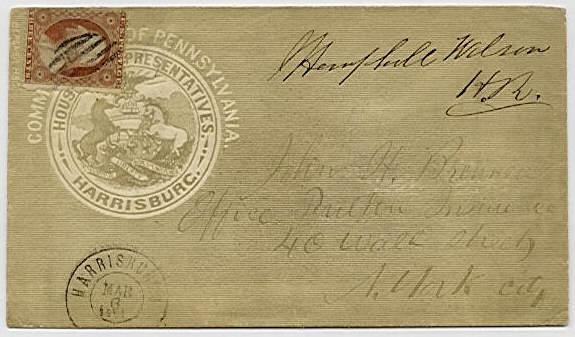
This cover bears a three cent 1857 issue adhesive with a grid style cancel. Please notice that if the stamp had been applied first and then cancelled, the cover would show evidence of the cancel tying the stamp to the cover. In fact, the stamp was precancelled in sheet form before being applied to the cover. There might be some doubt about the authenticity of the cover were it not for the additional example shown below from a different correspondence used the next day.
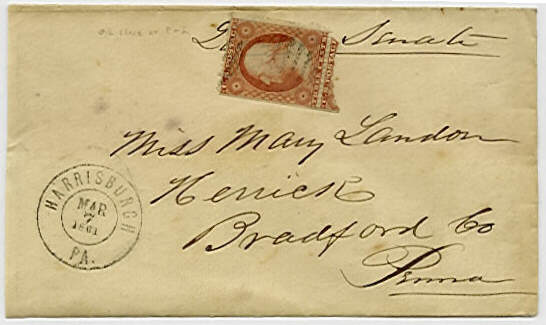
This cover has the adhesive placed over the Senator's frank. The grid precancel is identical to the previous example and if you note the top of the stamp shows very clearly that the grid cancel, had it been applied after the stamp was on the cover, would have convincingly tied the stamp to the cover.
In each of these examples there is no additional cancel applied by the Harrisburg post office, just the double circle postmark. The next example shows a nice example of one of the more commonly seen forms of the Harrisburg precancel. This cover, used February 27, 1864, from a Senator bears two copies of the manuscript "cross" version of the precancel on three cent 1861 issue stamps paying a double rate. It is readily apparent that these stamps were pen cancelled before application to the cover.
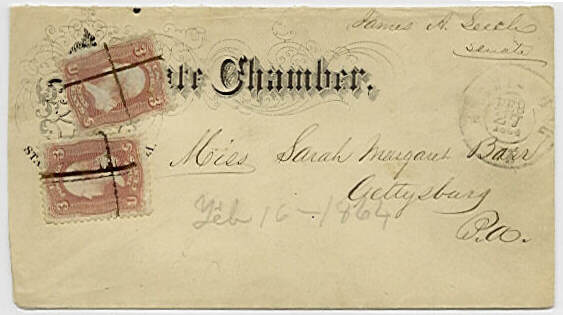
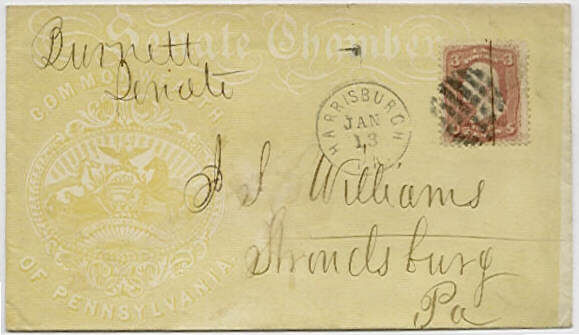
The next example shows another variant of the precancel. Here the precancel is the target cancel. In this example, of January 3, 1866, with original enclosure, the duplex Harrisburg cancel, applied after the stamp already had the target cancel, is the well documented fancy shield.
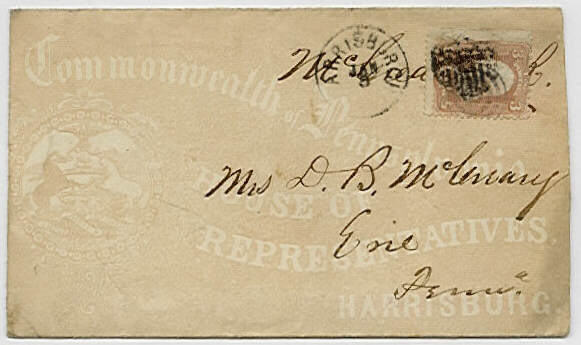
The final example, illustrated below, is from March 30, 1866 and bears the same target precancel. In this example the Harrisburg duplex postmark does not hit the stamp and is a very fine strike of the rare "peacock" fancy cancel.
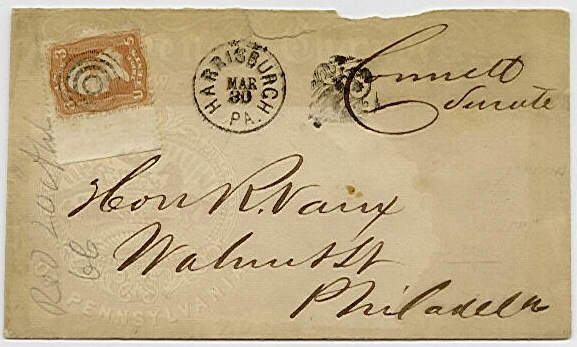
There are additional examples of the Harrisburg precancels, mostly of the brush or manuscript style, reported as late as March 11, 1869.
There remains much work to be done in the study of these precancels. It would be interesting to learn where the precanceling took place (either at the post office or less likely at the Legislative offices), how the accounting between the Harrisburg post office was reconciled with their usage, if their usage corresponded with known legislation dates or was done as a convenience to the postmaster, and what other types may have been used. The rare target and grid styles shown above are not well documented which is born out by the erroneous Philatelic Foundation certificate that the above cover received in 1981 which stated that the stamp did not originate. I estimate that fewer than five examples of the precancel on the 1857 issue exist.
Richard Frajola (June, 2000)


